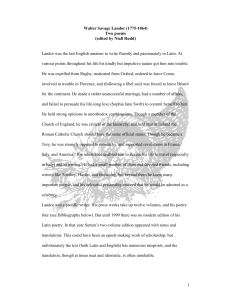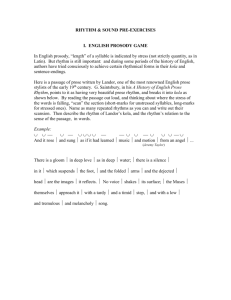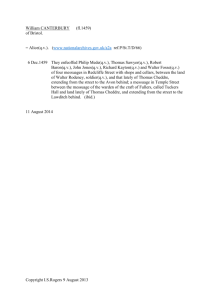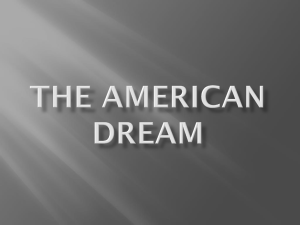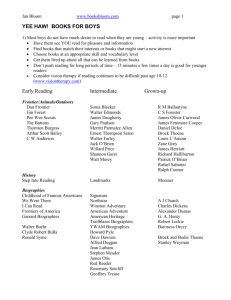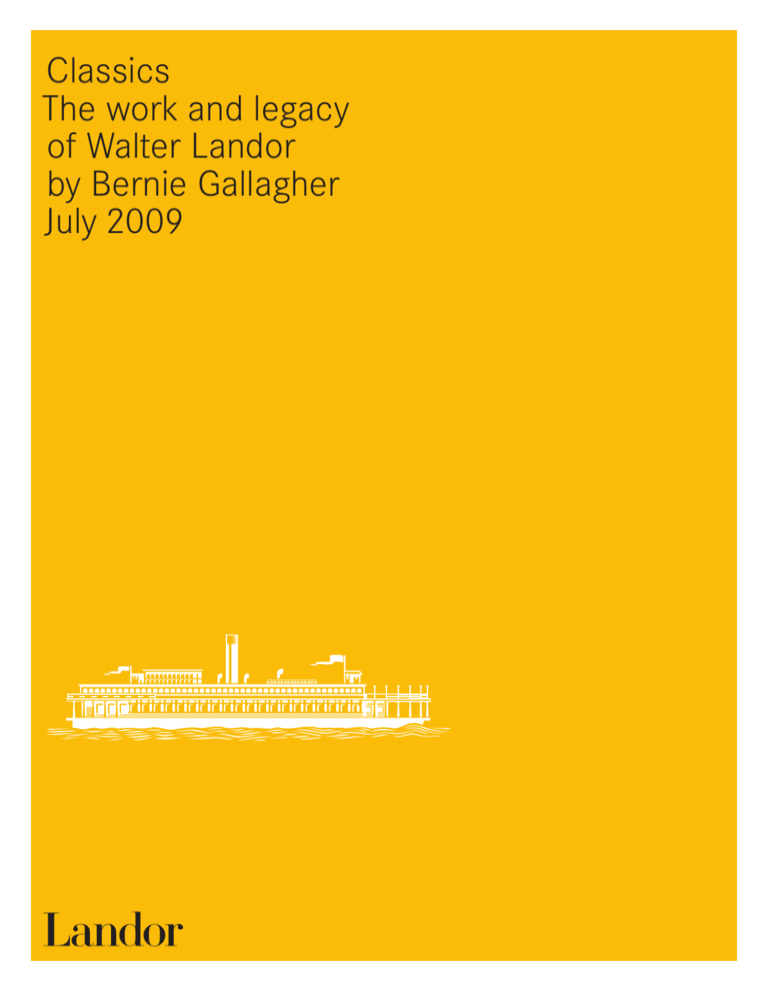
Classics
The work and legacy
of Walter Landor
by Bernie Gallagher
July 2009
Classics
The work and legacy
of Walter Landor
Following are just a few examples of Walter
Landor’s work and legacy, with brief descriptions of the creative processes involved. The
first five express the timeless quality of Walter’s
designs, while the last five demonstrate the
personal and emotional connections such
symbols establish between companies and their
customers.
“A good design should last. If the effort doesn’t show,
then it’s a good design. It must never look designed.”
–Walter Landor
Cotton Incorporated
J. Dukes Wooters, former president of Cotton
Incorporated, met with Walter Landor aboard the
Klamath in 1971 to discuss the association of cotton
growers’ need for a new logo. The design had to
identify cotton as a homegrown alternative to
synthetic fabrics, and convey a sense of its being
“natural … timeless.”1 Landor’s team came up with
the tagline a natural wonder and the graphic
portraying a cotton boll growing out of the two t’s to
communicate that cotton is unique and pure, an
organic fiber with a bloom and roots.
2
Classics
Bernie Gallagher
July 2009
Bernie Gallagher is senior documentation
specialist at the Smithsonian National
Museum of American History.
© 2009 Bernard Gallagher and Landor
Associates. All rights reserved.
left The final design for Cotton Incorporated.
1 Rodney McKnew, telephone interviews by Jessica
Myerson (13 April, 7 May, 2 June, 4 June, 8 July 1993),
transcript from the Landor Archive Project, Landor
Design Collection, Archives Center, National Museum
of American History.
3
Classics
Bernie Gallagher
July 2009
left Landor’s design for Alitalia aircraft.
MIDDLE Levi’s “batwing” garment tag.
BOTTOM Ore-Ida Golden Fries packaging.
Levi’s
When Levi Strauss & Co. executives wanted a new
garment label for their blue jeans in 1969, they came
to Walter Landor, whose designers developed the
distinctive red-and-white “batwing” to be placed on
back pockets. The red shield mimicked the pocket’s
stitch pattern and incorporated the Levi’s lettering.
This was among the first designs to mix capital and
lowercase letters throughout a single logo.2
Alitalia Airlines
In 1967 the national airline of Italy—a country
celebrated for its fine designers—selected Walter
Landor of San Francisco to create a new identity
system for its aircraft. Although Alitalia was an
international carrier, Landor’s interviews revealed
that air travelers thought of it as a small domestic
line. Alitalia’s image also needed to be modernized.
The graphics had to be adaptable to a complex
variety of aircraft, such as 747s and DC-10s, as well
as flight uniforms, plane interiors, ticket counters,
and printed materials. Landor’s aggressively visible
design emphasized the vibrant spirit of the Italian
people. The logo is “very classical. Fortunately, it
had a vertical stabilizer that was the A in Alitalia.…
It’s still [as] good today as it was then.”3
Ore-Ida
After nearly 20 years in the frozen-food business,
Ore-Ida Foods of Boise, Idaho, approached Walter
Landor in the late 1960s to develop new package
designs for its potato products. Landor’s consumer
research found that the Ore-Ida name itself had
greater recognition than the logo outline representing Oregon and Idaho. In addition, the company’s
cellophane bags and waxed paper containers were
outdated. Landor’s final bi-leaf design was placed
on white poly bags showing photos of the products
they contained.
2 David Bowman, interview by Jessica Myerson (15 April
1993), transcript from the Landor Archive Project, Landor
Design Collection, Archives Center, National Museum of
American History.
3 Rodney McKnew with Taft Tong, Lillian Sader, Richard
Young, and Sheppard P. Pollack, interview by Jessica
Myerson (5 July 1993), transcript from the Landor Archive
Project, Landor Design Collection, Archives Center,
National Museum of American History.
4
Classics
Bernie Gallagher
July 2009
left The refreshed Del Monte ram’s
head label.
below left Sign for a Wells Fargo
bank branch.
below right The lighter, playful
Frito-Lay logo.
Del Monte
In 1967 the country’s leading manufacturer of
canned fruits and vegetables changed its name
from the California Packing Corporation to Del
Monte Foods, the oldest and best known of its retail
brands. Company president Jack Countryman asked
Walter Landor to update the ornate “ram’s head”
shield that had been used on Del Monte product
packaging since the early 1900s. The job was a
perfect match between Walter’s design philosophy
and the new image Del Monte wanted to project.
While retaining the shield’s basic elements, the
Landor team streamlined and simplified the symbol,
resulting in an understated elegance that has stood
the test of time.4
“Design should connect—connecting what the client
is selling.” – Walter Landor
Wells Fargo
Landor revived the well-known historic image of
the Wells Fargo stagecoach in 1960 when Wells
Fargo Bank merged with American Trust Company.
The new bank’s officers realized that the “trust”
lay with Wells Fargo, while the image of a modern,
progressive bank belonged to American Trust
Company. Landor’s symbol set the stagecoach
inside a contemporary stylized diamond. This
combination of old and new placed Wells Fargo
in the forefront of consumer recognition for
banking services. A Landor survey reported that
“72 percent of Californians [could] identify it,
without any lettering.”5
Frito-Lay
Frito-Lay, the acknowledged “leader in the snack
food world,” turned to Walter Landor in 1979 to
create a new corporate visual identity that “could
be applied nationally on all packages, point of sale
[displays], stationery, trucks, and signs.” Landor’s
consumer research determined that the company’s
brand equity resided in the Frito-Lay name but not
in its existing graphic symbol. The design team
produced an eye-catching logo in which the letters
F and Y curved to resemble snack chips, offering a
“lighter, playful look of food and fun.”6
4 Richard Young with Lillian Sader, Edward Skubic, and
George McLean, interview by Jessica Myerson (16 June
1993), transcript from the Landor Archive Project, Landor
Design Collection, Archives Center, National Museum of
American History.
5 Philip Durbrow, “Design Systems: Compound Interest on
Identity Equity,” United States Banker (May 1984); and
Joan Chatfield-Taylor, “Designing the World Around Us,”
San Francisco Chronicle (27 July 1979).
6 Ruth, MacIver, “F-L’s New Look Provides Increased
Visibility,” Snack Food (January 1981).
5
Classics
Bernie Gallagher
July 2009
left A FedEx delivery truck with the tagline
The World On Time.
below left Most people see a bird in the
BA monogram for Bank of America.
below right The World Wildlife Fund panda
created in 1986 is still in use today.
Bank of America
As the largest bank in the United States, Bank of
America provided a full range of financial services.
However, Landor’s consumer surveys found that
smaller clients viewed the institution as impersonal
and oriented primarily toward large corporate
accounts. In addition, most people mistook its
existing sailing ship logo for the trademark of the
Encyclopedia Britannica. In 1969 Walter developed
the BA monogram to communicate “something
quite wonderful and strange happening between
[the two letters]. The majority of the people see
a bird. It was conceived as … a non-threatening
symbol more like an old-time monogram. It’s a very
personal statement.” The new logo helped Bank of
America present a friendlier face to customers.7
World Wildlife Fund
An adorable panda is the unmistakable embodiment
of the World Wildlife Fund, the largest privately
financed conservation group in the world. In 1986
Landor reworked the old logo, creating a strong,
recognizable symbol that would overcome all
language barriers. The fund still uses this furry
black-and-white ambassador to carry its preservation message throughout the world.8
FedEx
In June 1994, Landor capitalized on the strength of a
widely used colloquial name and officially turned
Federal Express into FedEx. The new designation
was simpler and had already gained currency as “a
household name and even a verb.” When creating
the new graphics, Landor maintained the traditional
purple and orange that had boldly identified Federal
Express in the past. An arrow within the new brand
name and the tagline The World On Time symbolize
“the company’s speed and efficiency.”9 ■
Bernie Gallagher is senior documentation
specialist at the Smithsonian National Museum
of American History. His expertise lies in data
mapping historical object information.
Bernie has worked at the museum for over 20
years, overseeing the cataloging of objects by
curators, specialists, volunteers, and interns and
maintaining proper data standards in the
database systems. His specialties include the
collections of information technology and
communications and work and industry.
Bernie earned an MA in history museum studies
from the Cooperstown graduate program at the
State University of New York, College at
Oneonta, where he wrote his thesis on Walter
Landor, “A Brand Is Built in the Mind: Walter
Landor and the Transformation of Industrial
Design in the Twentieth Century.” His research
and subsequent thesis form the basis of this
article.
7 Marty Olmstead, “Man of a Thousand Designs,”
PSA Magazine (March 1980).
8 World Wildlife Fund, “What is the story behind the panda
logo of WWF?” panda.org/faq/response.cfm?hdnQuesti
onId=26920021711544 (accessed 22 January 2006).
9 Peter Hall, “Stealth Identity Program. A Cold Call Lands a
Massive Makeover Job for Landor Associates—
Implemented Under a Cloak of Secrecy,” Step-By-Step
Graphics (January-February 1995).
www.landor.com
Beijing
Chicago
Cincinnati
Dubai
Geneva
Hamburg
Hong Kong
Istanbul
Jakarta
London
Madrid
Mexico City
Milan
Mumbai
New York
Oslo
Paris
San Francisco
Seoul
Shanghai
Singapore
Sydney
Tokyo
hello@landor.com

